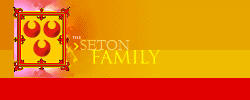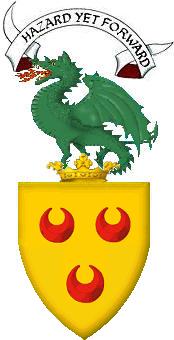The dynasty is usually considered to have been founded by Saint Arnulf, bishop of Metz in the early seventh century, who wielded a great deal of power and influence in the Merovingian kingdoms. His son Ansegisel married Saint Begga, the daughter of Pepin of Landen, and their son was Pepin of Heristal. It is from Pepin's grandfathers that the dynasty receives its earlier (pre-Martel) names: Arnulfing or Pippinid. The mayoralty of the palace of the kingdom of Austrasia began in the family with Ansegisel and continued with Pepin of Heristal. Pepin conquered Neustria at the Battle of Tertry in 687 and spread Arnulfing authority over all the Franks. Pepin was succeeded by his son, Charles Martel, as mayor, who in turn was the father of Pepin the Short. By this time the Merovingian rois fainéants (do-nothing kings) had no power which the mayors had not already taken in the preceding century of minorities, regencies, and civil wars. Pepin was crowned king in 751 with the support of the leading Frankish nobles and Pope Zachary, after the last Merovingian king, Childeric III was deposed, tonsured, and put up in a monastery. Charlemagne, Pepin's son, became king of the Franks in 768 and was crowned Holy Roman emperor by Pope Leo III in 800. His son, Louis the Pious, was his sole successor, but upon Louis death and the end of his unrestful reign followed three years of civil war between his sons: Lothair, Louis the German, and Charles the Bald.
After the division of the empire between the three grandsons of Charlemagne with the Treaty of Verdun in 843, the Carolingians initially continued to hold the throne in all three sections that were created: West Francia, Middle Francia, and East Francia.
- In the West, which was the nucleus of later France, they continued to be the ruling dynasty until the Capetians, perhaps descendants on the distaff side of Louis the Pious, ascended the throne in 987.
- In the Middle, with the empty title of Emperor and that which would be the kingdoms of Lotharingia and Provence, as well as the Iron Crown of Lombardy (Italy), the major branch of the family ruled till 875, but further division occurred with the Treaty of Mersen in 870.
- In the East, the kernel of later Germany and the Holy Roman Empire, the Carolingians ruled until 911, the death of Louis the Child. Here, the dukes of the stem duchies eventually acclaimed a Saxon dynasty, commonly referred to as the Ottonians, who consciously modelled themselves as Carolingian successors.
Arnulf's more distant descent from a 4th-century "Mellobaude" may be a genealogical fantasy to flatter the Carolingians:
- Mellobaude (320-376)
- Richemir (350-384) married Ascyla (d.352)
- Theodemir Magnus (370-414) married Valentina Justina (d.414)
- Clovis the Ripuarian (398-448) married Ildegonde de Cologne (399-450)
- Childebert of Cologne (430-483) married Amalaberge (435-478)
- Siegbert the Lame (d.509)
- Cloderic of Cologne (477-509) also known as Cloderic "the Parricide"
- Munderic (500-532) married Arthenia (500)
- Bodegisel I married Palatina
- Bodegisel II (d.588) married Oda of Suevian
- Arnulf (582-641) married Dode (586-612)
Saint Arnulf of Metz (August 13, 582 – August 16, 640) was a Frankish noble who had great influence in the Merovingian kingdoms as a bishop and was later canonized as a saint. He is also known by his anglicized name, Arnold.
Pippin of Herstal (or Pepin; Fr. Pépin), also known as Pippin the Middle, Pippin the Younger (as with his grandson), Pippin the Fat, or Pippin II, (635 or 640–December 16, 714) was the grandson of Pippin (I) the Elder by the marriage of Ansegisel and Begga, the daughter of the Elder. He was born in Herstal (fr Héristal), Belgium, hence his byname. His other bynames and his ordinal number come from his position as the second "Pippin" (of three) in the Arnulfing dynasty. Pippin was the Mayor of the Palace of Austrasia from 680 and of Neustria and Burgundy from 687 until his death in 714.
Charles Martel (or, in modern English, Charles the Hammer) (23 August 686 – 22 October 741) was proclaimed Mayor of the Palace, ruling the Franks in the name of a titular King, and proclaimed himself Duke of the Franks (the last four years of his reign he did not even bother with the facade of a King) and by any name was de facto ruler of the Frankish Realms. He expanded his rule over all three of the Frankish kingdoms: Austrasia, Neustria and Burgundy. Martel was born in Herstal, or present-day Wallonia, Belgium, the illegitimate son of Pippin the Middle and his concubine Alpaida (or Chalpaida).
Charlemagne (Holy Roman Emperor) (Latin: Carolus Magnus, meaning Charles the Great) (742 or 747 – 28 January 814) was the King of the Franks (768–814), who conquered Italy and took the Iron Crown of Lombardy in 774 and, on a visit to Rome in 800, was crowned Emperor by Pope Leo III on Christmas Day, presaging the revival of the Roman imperial tradition in the West in the form of the Holy Roman Empire. By his foreign conquests and internal reforms, Charlemagne helped define Western Europe and the Middle Ages. His rule is also associated with the Carolingian Renaissance, a revival of the arts and education in the West. The son of King Pepin the Short and Bertrada of Laon, his original name in the Old Frankish language was never recorded, but early instances of his name in Latin read "Carolos" or "Karol's". He succeeded his father and co-ruled with his brother Carloman until the latter's death in 771
Louis the Pious (also known as Louis I, Louis the Fair, and Louis the Debonaire, German: Ludwig der Fromme, French: Louis le Pieux or Louis le Débonnaire, Italian: Luigi il Pio or Ludovico il Pio, Spanish: Luis el Piadoso or Ludovico Pío) (16 April 778 – 20 June 840) was Emperor and King of the Franks from 814 to his death in 840. Louis was born at the Carolingian villa of Cassinogilum, according to Eginhard and the anonymous chronicler called Astronomus, on 16 April 778, the third son of Charlemagne by his third wife, Hildegard.
Charles the Bald (numbered Charles II of France and the Holy Roman Emperor) (French: Charles le Chauve) (13 June 823 – 5 or 6 October 877), Holy Roman Emperor (875-877) and king of West Francia (840-877), was the youngest son of Emperor Louis the Pious, by his second wife Judith.
Louis the Stammerer or Louis II (November 1, 846 – April 10, 879), in French Louis le Bègue, was the eldest son of Charles the Bald and Ermentrude of Orléans. He succeeded his younger brother in Aquitaine in 866 and his father in France in 877, though he was never crowned Emperor. Thrice married, he and his first wife, Ansgarde of Burgundy, had two sons: Carloman and Louis, both of whom became kings of France, and two daughters: Gisela and Hildegarde. He had no children by his second wife, Luitgarde of Saxony. With his third wife, Adelaide of Paris, he had one daughter, Ermentrude, and a posthumous son, Charles the Simple, who would become, long after his elder brothers' deaths, king of France. On his death, his realms were divided between his two sons, Carloman and Louis.
Louis IV (920 – September 10, 954), called d'Outremer or Transmarinus, reigned as king of France from 936 to 954, a member of the Carolingian dynasty, the son of Charles III and Eadgifu of England, a daughter of King Edward the Elder. He was only two years old when his father was deposed by the nobles, who set up Robert I in his place. When he was only three years old, Robert died and was replaced by Rudolph, duke of Burgundy. Rudolph's ally, a Carolingian himself, Count Herbert II of Vermandois, took Charles captive by treachery and the young Louis's mother took the boy "over the sea" to the safety of England, hence his nickname. In 939, Louis became involved in a struggle with the Emperor Otto the Great on the question of Lorraine, but then married Otto's sister Gerberga of Saxony (914 – May 5, 984). They had two sons and a daughter: Lothair, his successor; Charles, later duke of Lower Lorraine; and Matilda, who married Conrad the Pacific, King of Burgundy. Louis IV fell from his horse and died September 10, 954, at Rheims, in the Marne, and is interred there at Saint Rémi Basilica.
Gerberge of Lorraine (975-1018) was the daughter of Charles, duke of Lower Lorraine. She was a seventh generation descendant of Charlemagne, and married Lambert I Count Louvain in circa 994. Lambert I was the son of Reginar III Count of Hainault (d.973) and Adela (d. 961), and who were descended from Giselbert II (830-892) and Irmgard, daughter of Emperor Lothar I.
Maud of Louvain (975-1018) was the daughter of Lambert I Count Louvain and Gerberge of Lorraine. She was an eighth generation descendant of Charlemagne, and married Eustace I count of Boulogne.
______________________________________________________________________
Saint Angilbert (†February 18, 814) son of Nithard and Richarda (daughter of Jerome) was a Frank who served Charlemagne as a diplomat, abbot, poet and semi-son-in-law via his daughter Bertha. He was of noble Frankish parentage, and educated at the palace school under Alcuin. His poems reveal the culture and tastes of a man of the world, enjoying the closest intimacy with the imperial family. He accompanied Charlemagne to Rome in 800 and was one of the witnesses to his will in 814. Angilbert was the Homer of the emperor's literary circle, and was the probable author of an epic, of which the fragment which has been preserved describes the life at the palace and the meeting between Charlemagne and Leo III. Angilbert's non-sacramental relationship with Bertha was evidently recognized by the court - if she had not been the daughter of the King historians might refer to her as his concubine. They had two sons: Nithard, and Arsinde (Hartnid) who married Remy. Nithard became a notable figure in the mid-9th century. He is venerated as a saint, on the day of his death—18 February.
Baldwin II of Flanders (c. 865 – September 10, 918) and count of Boulogne (896-918), nicknamed Calvus (the Bald) was the second count of Flanders. He was also hereditary abbot of St. Bertin from 892 till his death. He was the son of Baldwin I of Flanders and Judith, a daughter of Charles the Bald. In 884 Baldwin married Aelfthryth (Ælfthryth, Elftrude, Elfrida), a daughter of King Alfred the Great of England. The marriage was motivated by the common Flemish-English opposition to the Vikings, and was the start of an alliance that was a mainstay of Flemish policy for centuries to come. In 900, he tried to curb the power of Archbishop Fulk of Rheims by assassinating him, but he was excommunicated by Pope Benedict IV. He died at Blandimberg and was succeeded by his eldest son Arnulf I of Flanders. His younger son Adalulf was the first count of Boulogne.
In 934 he married Adele of Vermandois, daughter of Herbert II of Vermandois. Their children were:
- Luitgard, married Wichmann, Count of Ghent
- Egbert, died 953
- Baldwin III of Flanders
- Elftrude, married Siegfried, Count of Guines
He also had a previous daughter, Hildegard. Arnulf made his eldest son and heir Baldwin III of Flanders co-ruler in 958, but Baldwin died untimely in 962, so Arnulf was succeeded by Baldwin's infant son, Arnulf II of Flanders.
Baldwin III of Flanders (940–January 1, 962) was count of Flanders together with his father Arnulf I. He died before his father and was succeeded by his infant son Arnulf II, with his father acting as regent until his own death. Arnulf I had made Baldwin co-ruler in 958. During his short rule, Baldwin established the weaving and fulling industry in Ghent thus laying the basis for the economical importance of the county in the centuries to come. In 961 Baldwin married Mathilde of Burgundy, by whom he had a son and heir Arnulf II, and his second son Guy became Count of Guines.
Guy, Count of Guines, (933-987), he married Adeline of Holland.
Baldwin II, count of Boulogne, was a son of Count Guy of Guines and Adeline of Holland. He held the county from 1046 until his death in 1049. He was married with Adeline of Holland (West Friesland in Ghent), daughter of Lambert I of Louvain and had two children, Eustace I and Matilda of Boulogne who married Count Ardolph of Guines.
Eustace I, count of Boulogne, was a son of Count Baldwin II and Adeline of Holland. He held the county from 1046 until his death in 1049. He was married with Maud de Louvain, daughter of Lambert I of Louvain and had two children, Eustace II and Lambert de Lens.
______________________________________________________________________
By the 6th century, the Franks were Christianised, and the Frankish Empire ruled by the Merovingians had become the most powerful of the kingdoms which succeeded the Western Roman Empire. But following the Battle of Tertry, the Merovingians declined into a state of powerlessness, for which they have been dubbed do-nothing kings (French: rois fainéants). Practically all government powers of any consequence were exercised by their chief officer, the mayor of the palace or major domus.
In 687, Pepin of Herstal, mayor of the palace of Austrasia, ended the strife between various kings and their mayors with his victory at Tertry and practically became the sole governor of the entire Frankish kingdom. Pepin himself was the grandson of two most important figures of the Austrasian Kingdom, Saint Arnulf of Metz and Pepin of Landen. Pepin the Middle was eventually succeeded by his illegitimate son Charles, later known as Charles Martel (the Hammer). After 737, Charles governed the Franks without a king on the throne but desisted from calling himself "king". Charles was succeeded by his sons Carloman and Pepin the Short, the father of Charlemagne. To curb separatism in the periphery of the realm, the brothers placed Childeric III on the throne, who was to be the last Merovingian king.
After Carloman resigned his office, Pepin had Childeric III deposed with Pope Zachary's approval. In 751, Pepin was elected and anointed King of the Franks and in 754, Pope Stephen II again anointed him and his young sons, now heirs to the great realm which already covered most of western and central Europe. Thus was the Merovingian dynasty replaced by the Carolingian dynasty, named after Pepin's father Charles Martel and its most famous member, Charlemagne.
Under the new dynasty, the Frankish kingdom spread to encompass an area including most of Western Europe. The division of that kingdom formed France and Germany;[2] and the religious, political, and artistic evolutions originating from a centrally-positioned Francia made a defining imprint on the whole of Western Europe.
Charlemagne's birthday was believed to be April 2, 742; however several factors led to reconsideration of this traditional date. First, the year 742 was calculated from his age given at death, rather than attestation within primary sources. Another date is given in the Annales Petarienses, April 1, 747. In that year, April 1 is Easter. The birth of an emperor on Easter is a coincidence likely to provoke comment, but there is no such comment documented in 747, leading some to suspect that the Easter birthday was a pious fiction concocted as a way of honoring the Emperor. Other commentators weighing the primary records have suggested that the birth was one year later, 748. At present, it is impossible to be certain of the date of the birth of Charlemagne. The best guesses include April 1, 747, after April 15, 747, or April 1, 748, in Herstal (where his father was born), a city close to Liège, in Belgium, the region from which both the Meroving and Caroling families originate. He went to live in his father's villa in Jupille when he was around seven, which caused Jupille to be listed as possible place of birth in almost every history book. Other cities have been suggested, including, Prüm, Düren, or Aachen.
Einhard says of the early life of Charles:
- It would be folly, I think, to write a word concerning Charles' birth and infancy, or even his boyhood, for nothing has ever been written on the subject, and there is no one alive now who can give information on it. Accordingly, I determined to pass that by as unknown, and to proceed at once to treat of his character, his deed, and such other facts of his life as are worth telling and setting forth, and shall first give an account of his deed at home and abroad, then of his character and pursuits, and lastly of his administration and death, omitting nothing worth knowing or necessary to know.
This article follows that general format.
On the death of Pepin, the kingdom of the Franks was divided—following tradition—between Charlemagne and Carloman. Charles took the outer parts of the kingdom, bordering on the sea, namely Neustria, western Aquitaine, and the northern parts of Austrasia, while Carloman retained the inner parts: southern Austrasia, Septimania, eastern Aquitaine, Burgundy, Provence, and Swabia, lands bordering on Italy. Perhaps Pepin regarded Charlemagne as the better warrior, but Carloman may have regarded himself as the more deserving son, being the son not of a mayor of the palace, but of a king.








